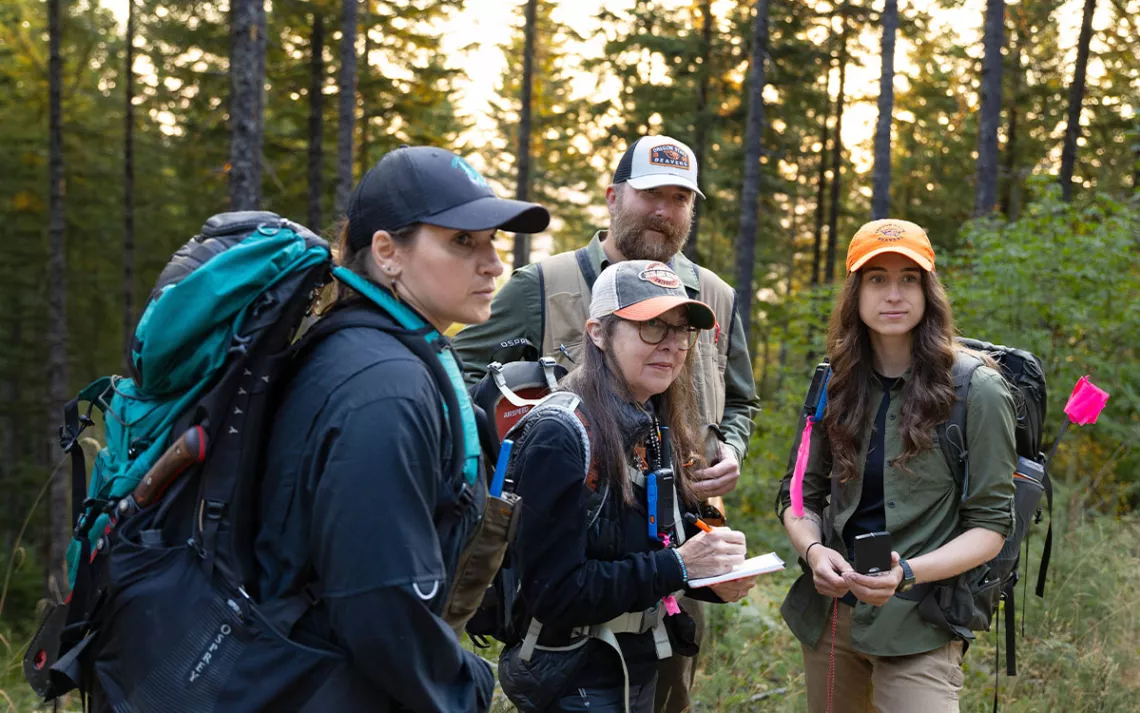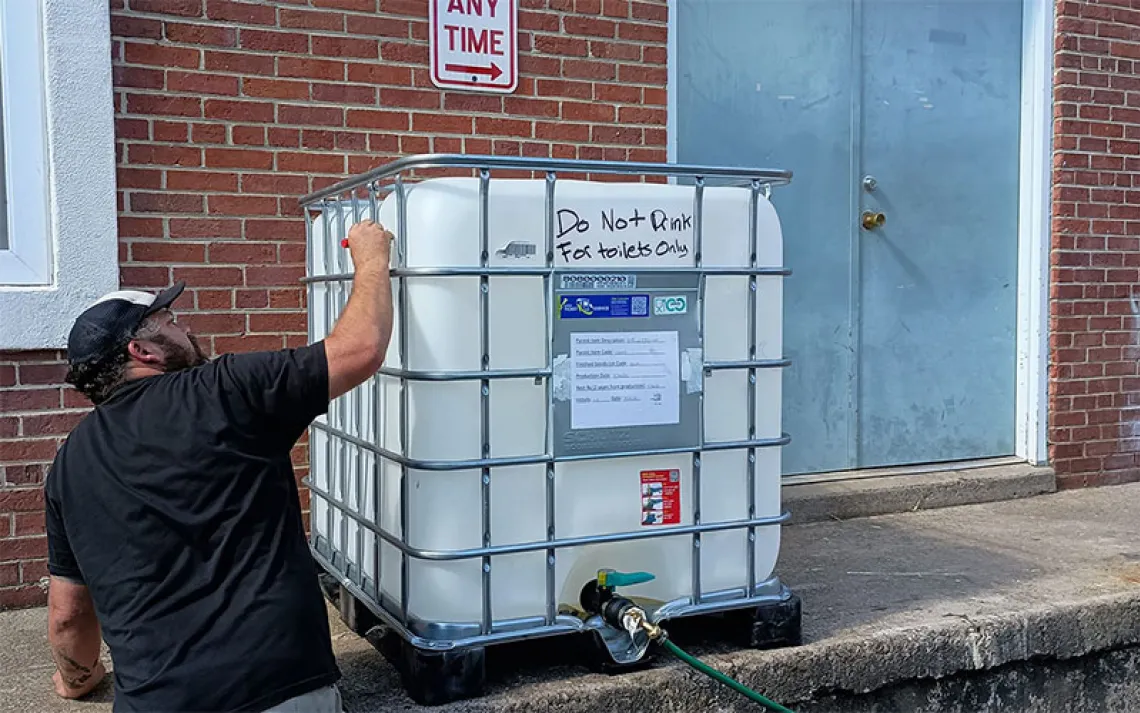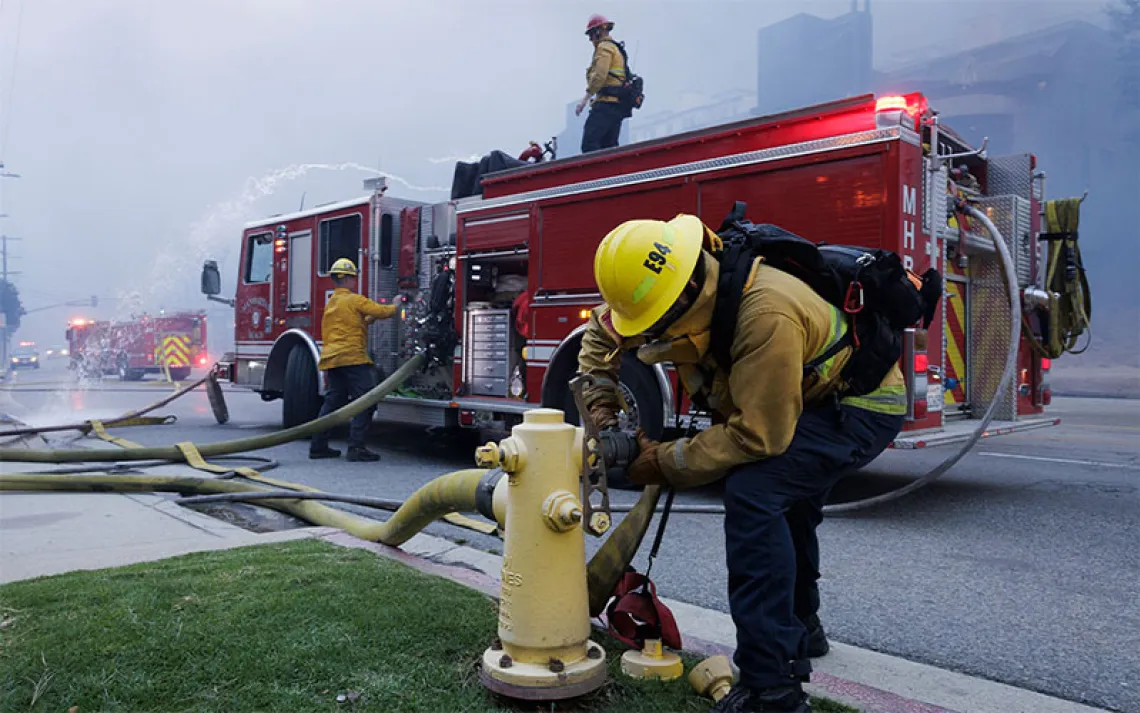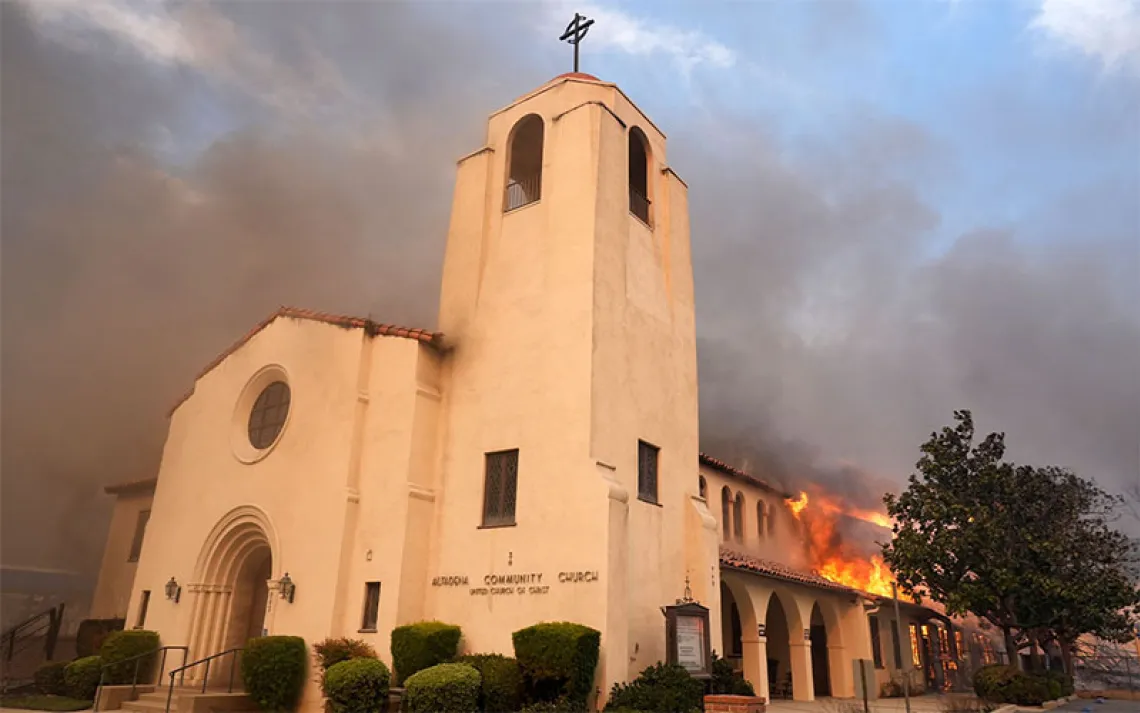Forest Service, Native American Tribes Partner to Promote Forest Resilience
The consultation process puts tribal knowledge to work for forest management

Members of the Traditional Ecological Knowledge Lab at Oregon State University and representatives of the Confederated Tribes of Coos, Lower Umpqua and Siuslaw Indians survey tribal forestland. From left are Ashley Russell, Cristina Eisenberg, Colin Beck, and Tessa Chesonis. | Photo courtesy of OSU
Chris French, a top official with the US Forest Service, has one overriding concern: how to protect national forestlands from a daunting array of environmental challenges. In 2020 and 2021, more than 2.5 million acres of national forests burned with high severity, according to the agency; in 2022, the Forest Service observed 8.4 million acres of tree mortality caused by insects and diseases.
Now the agency is taking an unprecedented step toward protecting forests, actively seeking partnerships with Native American tribes to better meet the challenge. “There’s so much for us to learn,” French, the deputy chief of the National Forest System, a unit of the Forest Service, told Sierra. “These forests were resilient for centuries and centuries with the Indigenous management.” With the “rapid change” in environmental conditions, he said, the agency needs to incorporate tribal knowledge “to give us the best chance going forward.”
In December, when the Forest Service announced two major forest plan amendments, it emphasized the crucial role of tribal co-stewardship in managing these lands. Indigenous practices emphasize restoring more intentional burning to landscapes that evolved with fire, along with reciprocity with the natural world. First, on December 18, the agency announced it would amend the historic 1994 Northwest Forest Plan, encompassing 24.5 million acres across Washington, Oregon, and Northern California. (The amended plan covers 19.4 million acres.) It needed revision, the Forest Service stated, given hotter, drier, and longer fire seasons, and also because tribal involvement was “overlooked” in the 1994 plan even though it covered ancestral homelands to numerous tribes. The agency now regards tribal engagement as “critical to success” for the plan.
Then on December 20, it posted its National Old-Growth Amendment. That seeks updates to protect the 25 million acres of remaining old-growth stands in national forests from wildfire, insect and disease outbreaks, and extreme weather, while safeguarding their vital role in forest carbon capture. The old-growth amendment calls for federal land managers to “establish a clear role for Indigenous knowledge and tribal leadership” in national forest plans. It also directs Forest Service staff to “effectively braid place-based Indigenous knowledge and Western science” in the quest to maintain and expand old-growth forests.
The term braid is new to the lexicon of the Forest Service. The agency was the lead funder of a first-of-its-kind report on the concept. Braiding Indigenous and Western Knowledge for Climate-Adapted Forests, published on March 25, serves as a guidebook for Forest Service land managers. More than 40 experts contributed to the report, with equal representation from tribes, Forest Service staff, and Western university scientists.
Cristina Eisenberg, an associate dean in the College of Forestry at Oregon State University and a Native American, is one of the report’s lead authors. “You don’t blend the two knowledge systems, because Indigenous knowledge is very different from Western science. They complement each other,” Eisenberg said. “And our shared deep concern about what’s happening to the natural world is that third strand that brings everything together.”
The report also delves into two-eyed seeing, another term new to the Forest Service. It refers to a type of binocular vision—with one eye viewing the strengths of Indigenous science and the other viewing the strengths of Western science. The 102-page report urges a more active, and thoughtful, management that includes judicious forest thinning and other fuel reduction treatments, intentional low-intensity burning—which helps clear overgrown understory, promote seedling growth, and improve soil health, among an array of benefits—and native seed collection.
M. Kat Anderson, a research associate in the Department of Plant Sciences at UC Davis and author of Tending the Wild: Native American Knowledge and the Management of California's Natural Resources, is thrilled by this shift at the Forest Service. She’s been a pioneering researcher in the field for decades. (She wasn’t involved in the new report.) “This is huge. It’s such a paradigm shift,” she said. “The agencies are recognizing that Native Americans were the first silviculturists, the first fire ecologists on the land.”
In contrast to conventional Western science forest management, which largely focused on a handful of species, trees especially, Indigenous tribes “were managing for many, many species,” Anderson said. And they fully understood the importance of frequent, low-intensity fire on the landscape for supporting plant renewal, and all the life dependent upon that growth. As an example, she said a tribe knew that elk preferred specific plants that grow in grasslands. The tribe would then set fires to keep open areas so elk could feed and reproduce, which also ensured a source of food for the tribe. And the current buildup of duff and other plant debris on the forest floor not only increases the odds of a wildfire, but it squelches the growth of plants like shrubs, herbs, and grasses. That in turn cuts off food sources for an array of herbivores.
“Then pollinators can’t pollinate, rabbits can’t eat the greens and the seeds,” Anderson said, adding that moles, voles, and birds also like seeds. Without host plants, insect populations decline, shrinking another food source for birds and other animals. “It gets very complex, very fast,” she said. Thick duff layers also hinder rainwater from reaching the soil. “So it doesn’t feed the tree roots and, as importantly, it doesn’t get into the mycorrhizae, which they would soak up and give to the trees,” Anderson said. “Our forests are in shambles in many places, and our poor animals are suffering.”
French, the Forest Service official, acknowledges the role of past management practices in the current situation. The high loss of forestlands to fire and insect and disease outbreaks “was a consequence of us removing fire from many of these systems for the past 100 years,” he said.
Tribal consultation isn’t foreign to the Forest Service, but this new effort integrates it far more deeply into regular operations. In February 2023, the agency even changed the name of its State and Private Forestry unit to “State, Private, and Tribal Forestry.” It’s driven by the Biden administration. Several White House and secretarial directives, starting in 2021, spurred a series of actions, along with reports and manuals, such as the Forest Service’s pivotal Tribal Action Plan for strengthening tribal consultation. These directives also focus on honoring longtime federal trust and treaty obligations with tribal nations.
Ryan Reed, a member of the Hoopa Tribe in Northern California, is also member of a 21-person federal advisory committee for the Northwest Forest Plan. (And at 23, he’s the youngest.) He said true co-stewardship with tribes starts with early engagement in the planning process. Too often, he said, tribes are notified toward the end and then under pressure to find the people and resources to respond. The Northwest Forest Plan amendment was pushed to a mid-2025 estimated completion date at the request of tribes, to give sufficient consultation time. (The old-growth amendment completion is expected in early 2025.)
“With co-stewardship, you start at the beginning together—understanding what this project is, the objectives, how does that align with tribal values and perspectives,” Reed said. He pointed out that extra agency funding is also needed to build tribal capacity to co-develop national forest management plans, and the Forest Service needs to beef up its tribal liaison offices.
Reed added that not everyone embraces tribes sharing in policy decisions. But he’s seen Forest Service leaders working “to make some serious change” in tribal consultation practices. “Climate change has been an unfortunate vehicle for tribal leadership and knowledge to be reintroduced,” he said. “The colonial mismanagement ... in our forests since contact has really caught up with the rest of society. We have large catastrophic wildfires and fuel loading in our forests. And so now the agencies are in a pinch.”
Ted Catton, the author of National Forests and American Indians, for years witnessed various tribal consultation projects in national forests. Often, he said, it became “just a check-the-box exercise.” However, he said successful collaborations developed when strong relationships between officials and tribal leadership existed.
Another member of the federal advisory committee has noticed a change. “They are engaging with a different mindset,” said Ann House, senior staff attorney for the Snoqualmie Tribe in Washington. “There’s a cautionary optimism.”
Eisenberg, the co-lead of the report, said Forest Service leadership is “100 percent on board.” She’s running a series of roundtables this year, funded by the Forest Service, to convene tribes, federal agencies and conservation organizations to cultivate stronger collaborations, with the Braiding Indigenous and Western Knowledge report as a guide. “Because nobody knows how to do co-stewardship,” she said.
“We’re all in a learning space,” said French. In 2023, the Forest Service signed 120 new co-stewardship agreements with $68 million in investments, up from $20 million the previous year. “I’ve worked for the agency for 34 years,” he said. “And I have not seen a commitment or focus that we have as an agency to do better and to incorporate this work than I see right now.”
 The Magazine of The Sierra Club
The Magazine of The Sierra Club



